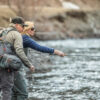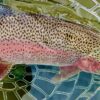Clark Shafer from The Nature Conservancy dropped by the store a few days ago to share a few updates and data packages with us. There are many voices of various perspectives and opinions about this project, and the folks of TNC and Silver Creek Preserve managers are working to make this info available for all to see and comment.

Areas colored yellow indicate proposed reseeded upland area. Areas in green for wetland area, and red shows proposed sections to dredge channel.
Some temperature and fish data from TNC’s 2012 Kilpatric Pond Science Report:
- Increasing summer temperature is a major threat to Silver Creek’s future;
- Kilpatrick Pond is one of the main contributors to rising water temperature in the Silver Creek watershed; and
- Insect, fish, and bird populations are negatively impacted by the pond and its associated sediment and temperature issues.
Temperature
Elevated temperatures have been documented throughout Kilpatrick pond with the 2004 thermal image and water temperature monitoring since 2004 (see savesilvercreek.com for data).
In 2012 TNC did an extensive study of water temperatures in Kilpatrick pond. Data gathered on August 7, 2012 showed the following:
● Rate of temperature increase above the pond is less than one degree Fahrenheit per mile
● Rate of temperature increase below the dam is 2o F per mile
● Rate of temperature increase through the pond is 24o F per mile
Fish
Effects of water temperature on rainbow trout:
- 66 degrees Fahrenheit is reported to be a physiological threshold for rainbow trout. Above this temperature, growth rates decline precipitously.
- When given a choice, rainbow trout prefer water 57-59o F. Rainbow trout achieve their maximum growth rate at 59o F. Their growth rate starts an exponential decline with warming temperatures.
- At 62o F their growth rate is significantly lower than at 59o F, and at 66o F there is a precipitous decline in growth. At 72o F their growth rate turns negative (they are respiring faster than they can take in food) and they begin to lose weight. 78o F is lethal (Hokanson, K.E., C.F. Kleiner, and T.W. Thorsund. 1977). Effects of constant temperatures and diel temperature fluctuations on specific growth and mortality rates and yield of juvenile rainbow trout, Salmo gairdneri. J. Fish. Res. Board Can. 34:639-648, Loinaz 2012).
Temperature measurement in 2012:
- In the S-Turns in 2012, a single day (July 5) had a maximum temperature > 66o Fahrenheit
- Above the dam, 34 days or 46% of the days had a maximum temperature of over 66 degrees
- Below the dam, at the USGS gage downstream, temperatures exceeded the threshold 66% of the days last summer (June-August).
Temperatures responses in Silver Creek trout
Brown trout tolerate and thrive in warmer water than rainbow trout. Their ideal temperature is around 68 degrees, with a threshold into the high 70s (Sigler, Fishes of the Great Basin, 1987).
A shift downstream of the Kilpatrick pond to an almost exclusively brown trout fishery can be attributed to degraded habitat and warmer water temperatures. As ESF noted in their 2010 report, “ The shift from rainbow to brown trout dominance is a function of habitat degradation (primarily temperature because browns have a higher tolerance) as well as piscivory (brown trout >13” feed primarily on smaller fish / rainbow trout feed on insects and to a lesser extent on small fish) (ESF 11)”.
Follow this link to see more project info.



